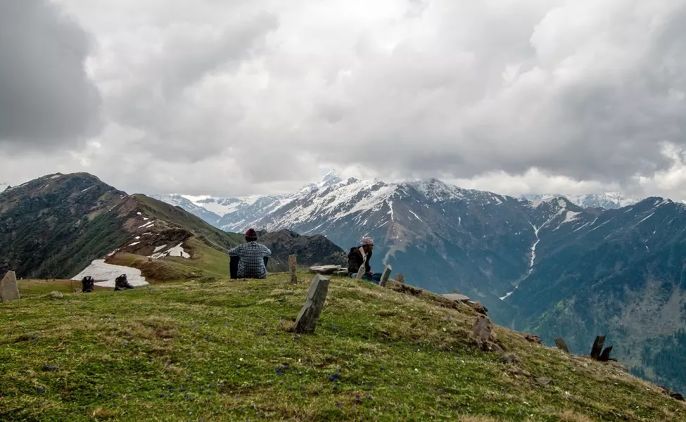
Introduction
The Chanderkhani Pass, located in the heart of the beautiful green Kullu Valley, is Himachal Pradesh’s most famous hike. The Chanderkhani Pass hike may be done at any time of year. The walk in the winter, on the other hand, offers a unique appeal and experience. The walk provides spectacular views of snow-covered woods, mountains, meadows, peaks such as Inderasan, Deo Tibba, Hanuman Tibba, and significant ranges such as the Bara Banghal Range, Pir Panjal Range, and Priyadarshini Range in the winter. Anyone, even those with little or no experience in the mountains, may complete this walk.
The journey begins at Naggar, at 1700 metres above sea level, on the left bank of the Beas River, an old town and former capital of Kullu (until 1460 AD).
Beginning of Route
Actually, the route to Chanderkhani Pass begins in Rumsu village. Rumsu is an old hamlet located a few kilometres north of Naggar. The path to the pass runs right through the heart of the settlement. Intricate sculptures adorn the temples in the hamlet. The rustic architecture of houses constructed of wood and stone is fascinating. In the centre of Rumsu hamlet, there are massive Deodar trees. These trees, which are located in the temple’s immediate vicinity, are thought to be hallowed and holy trees across the valley. These trees are so large that they require a large group of people to surround or keep them in place. The track leads us farther away from Rumsu to the first incline through the forest.
The start of the snow path will be determined by the weather and snowfall ratio. It might begin in the forests above Rumsu village, or farther up or down from Stelling. So, sooner or later, snow will emerge on the trail in some form. Tramping in the snow is not as easy as it appears in photographs. However, move carefully and steadily to avoid slipping or falling. After a few ups and downs, we arrive in Ghon Kradi. Our first night’s camp at Ghon Kradi is just a small meadow surrounded by massive trees and an abandoned shepherd’s cabin. In the local dialect, ‘Ghon-Kradi’ means ‘Hammer and Axe.’ It is one of the locations where residents used to gather wood for the winter.
Chill and Thrill
Under the blanket of snow, a few smaller trees and a lot more greenery can be seen. Walking in heavy snow might be difficult, but with determination and endurance, one can easily overcome these hurdles. As you go up the route, you will be able to see the entire Beas valley. Beyond the Beas valley, you can see the Dhauladar Range in all its snowcapped majesty. On the way uphill, immediately below the Naya Tapru, the ground is slightly steep (9,970ft). The picturesque beauty surrounding you, on the other hand, will make you forget about your exhaustion and pain. From afar, most of the Himalayan mountains may be seen from naya tapru, providing a relaxing istanbul escort girls vista.
The stunning Chandrakhani Pass climb offers a wealth of beautiful views. The trek to Chandrakhani Pass begins at Rumsu hamlet, about 5 kilometres from Naggar town, and continues to Malana village, which is known for its distinct and restricted social culture after reaching the Chandrakhani Pass at 3600 metres.
This hike passes through lovely alpine meadows with stunning vistas of some of the highest snow-capped mountain peaks and open valleys in the world. The route takes you through blue Pine and Deodar trees, as well as walnut, golden Oak, and wild Cherry trees.
The views from the Chandrakhani pass are spectacular, with the Pir Panjal range to the east and the Parvati range to the west. Chandrakhani Pass is a classic Himachal Pradesh trip that is suitable for all types of hiking.
Itinerary
Day 1: The first day is spent travelling from Manali to Ghankulhadi.
At the Manali Bus Stand, our trip leader and vehicle will greet you. After breakfast, we will depart for Rumsu town, which serves as the starting point for the journey to the Ghankulhadi campground.
The hike will take 3 to 4 hours and will include a modest ascent. In the meanwhile, we’ll take a few breaks and stop for lunch in Sterling. At the Ghankulhadi campground, you may spend the night in a tent.
Day 2: On the second day, we travelled from Ghankulhadi to Chaklani.
Begin your journey to the Chaklani campsite after breakfast. The Chaklani campsite, at 3,450 metres, offers spectacular views of the Manali valley. It takes around 4-5 hours to get reach the campsite.
Day 3: The third day is spent travelling from Chaklani to Malana over the Chandrakhani Pass.
This day of the walk is a little longer than the others, with a steady ascent and a severe descent. After breakfast, we’ll set off for Chandrakhani Pass summit, which is at 3660 metres. It’ll take us around 3 hours to get there from Chaklani Campsite.
At the summit of Chandrakhani Pass, eat your packed lunch. Spend some time at the peak before beginning your descent to Malana Camp Site. It’s a steep descent, so proceed with caution. We’ll need another three hours to get to Malana’s campground. At Malana campground, stay in tents for the night.
Day 4: The fourth day is spent travelling from Malana to Manali.
The route from Malana Village to the roadhead is steep but brief, especially when contrasted to the previous day’s adventure.
It will take around 2 hours to get at the roadhead, where our car will be waiting to transport you to Manali. The journey has come to an end.
With only a few periods of steady elevation, the trail is easy to follow. Stay the night in a tent in Chaklani campsite.